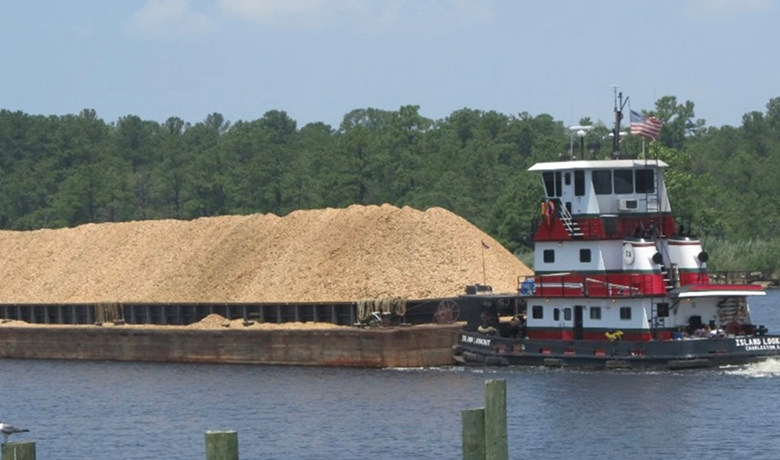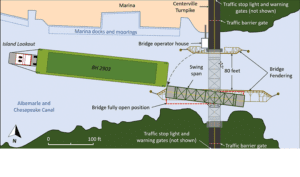

A mate helming a towboat in the Intracoastal Waterway misjudged his tow’s approach speed before colliding with a swing bridge near Chesapeake, Va., according to federal investigators.
The 1,350-hp Island Lookout was eastbound in the Albemarle and Chesapeake Canal when its single barge BH 2903 hit the Centerville Turnpike Bridge as it swung open.
The incident caused nearly $2.8 million in damage and closed the bridge to vehicle traffic for six months, according to the National Transportation Safety Board (NTSB).
Investigators determined “the tow’s speed of approach relative to the status of the swing bridge opening” was a leading factor in the collision. Its speed resulted in “insufficient time to slow the tow and avoid striking the bridge before it was fully open and safe to navigate.”
The 65-foot Island Lookout is operated by Stevens Towing of Yonges Island, S.C. The company disputed the NTSB findings.
Island Lookout left Baltimore with BH 2903 in tow on Nov. 12. It carried scrap steel bound for a plant in Hertford County, N.C. The initial voyage through the Chesapeake Bay into the Elizabeth River near Norfolk was uneventful.
The mate helming Island Lookout came on watch at 2300 on Nov. 13. He was familiar with the waterway and the route and had made similar voyages many times, the NTSB report said. The mate maneuvered the tow into the 10-mile-long Albemarle and Chesapeake Canal at about 0400. The waterway has a depth of 12 feet.
The Centerville Turnpike Bridge was the second bridge the eastbound tow encountered in the waterway. The bridge has a moveable span that opens counterclockwise. The width of the navigation channel when crossing through the open bridge was 80 feet.
The mate helming Island Lookout told investigators he called the bridge operator four times before receiving a response. He eased back on the throttles until he got through to the operator at about 0429. When he did, the bridge operator told him to “bring it on through,” and the tow proceeded at 3.9 knots for the next two minutes.
Warning gates began to close at 0431 and the bridge span began to open at 0432. The bridge was about halfway open when the unidentified mate on Island Lookout realized the span wouldn’t be fully open in time.
He backed the engines to slow the vessel down, which caused the barge to swing to port toward a marina near the bridge. He then put the port engine ahead and moved rudders to starboard to counter the barge’s motion to port.
“These actions turned the tow to starboard, and the mate said that he moved the throttle for the port engine back to 1,800 rpm astern,” the report said.
The tow slowed to about 2.8 knots by the time the barge’s bow was about 175 feet from the bridge. Its momentum carried it toward the structure. The forward starboard corner of the barge struck the end of the swing span at 0434.
No injuries or pollution were reported, but the barge sustained $34,000 in damage. The bridge’s steel beams, swing machinery and other equipment cost about $2.86 million to repair.
The approach to the Centerville Turnpike Bridge is narrow, and crewmembers knew BH 2903 tended to sheer to port or starboard in shallow water. As such, the NTSB determined, the mate should have exercised caution when approaching the span.
Once it became clear the bridge would not open in time, investigators acknowledged the mate had few options. Putting the engines hard astern pushed the barge toward the marina, where boats might have been occupied. The only alternative at that point was running into the bridge.
“Earlier action was required to avoid the accident,” the NTSB found.
Stevens Towing President Johnson Stevens suggested inaction by the bridge tender in the minutes leading up to the collision contributed to the incident.
“We agree with the NTSB finding that Island Lookout contacted the bridge operator half a mile, and six minutes, before reaching the bridge,” Stevens said.
“The swing bridge takes less than three minutes to open,” he continued. “At 0430 in the morning, there was no road traffic to delay the bridge opening. Had the bridge operator promptly initiated the bridge opening when he radioed to ‘bring it on through,’ the bridge would have long been fully opened for the laden tug and tow’s arrival, and this incident would not have occurred.”
The city of Chesapeake has completed a feasibility study to evaluate alternatives to the existing span, which dates to 1955 and is crossed by about 16,000 vehicles per day.
City officials could not be reached for comment on the NTSB findings.
